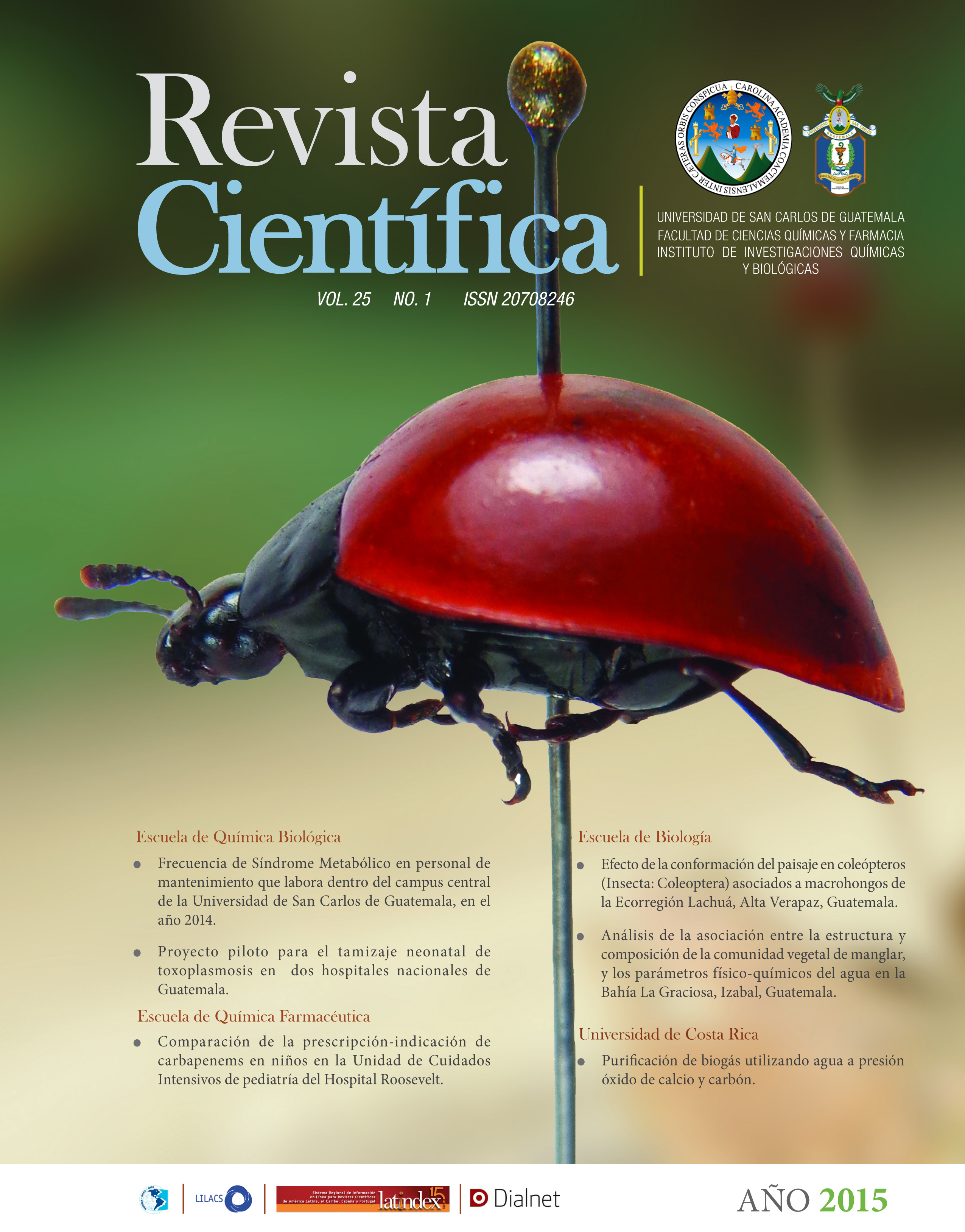Prevalence of Metabolic Syndrome on maintenance staff working at the main campus of the University of San Carlos of Guatemala, in 2014
DOI:
https://doi.org/10.54495/Rev.Cientifica.v25i1.93Keywords:
Metabolic syndrome, ATP III, cardiovascular disease, dyslipidemia, obesityAbstract
Metabolic Syndrome (MS) is a set of risk factors that occur simultaneously increasing the risk of cardiovascular diseases with a common pathophysiology. This study was based on a descriptive, prospective design made to 58 field workers in the maintenance area of the central campus of the University of San Carlos of Guatemala during 2014, were we applied the diagnostic criteria of the ATP III panel for MS and relate them with a conducted analysis to evaluate factors associated like level of blood pressure, waist circumference and 3 biochemical parameters (triglycerides, glucose and HDL) MS was estimated to have a frequency of 13.8% on the study sample, where 94.8 % are males and 5.2% females. The age group that had the highest rate was between 40-49 years old who presented positivity to MS conditions with 28.6%. The parameters most frequently encountered in the development of MS were finding increased serum triglycerides and HDL cholesterol decreased 77.6% and 62.1%, respectively.
Downloads
References
Bustos, A. (2003). Factores de riesgo de enfermedad cardiovascular en adultos. Revista Médica, 3(1), 50 - 62. https://doi.org/10.4067/S0034-98872003000900002
Carrillo, R. (2002). Síndrome Metabólico. México: UNAM.
Castañeda, S. (2013). Tratamientos benéficos en disminución de riesgo cardiovascular en síndrome metabólico. Revista Guatemalteca de Cardiología, 23 (1),21 – 28.
Diario Médico. (2005). La acumulación de grasa abdominal y muscular en mayores con peso normal seasociacon síndrome metabólico. Recuperado de http://www.fundaciondiabetes.org/adjuntos/04_2005%5C26.pdf
Hall, J., Hall, J. y Alvarenga, M. (2005). Prevalencia de hipertensión arterial en adultos de El Progreso. Revista Médica de Honduras, 73, (1), 60-64.
Iñiguez, C. (2005). Prevalencia del síndrome metabólico y su asociación con otros factores de riesgo en el personal del hospital regional universitario de colima.(Tesis de maestría), Universidad de Colima, Colima, México.
Kannel, W. (2002). La tensión arterial como factor de riesgo cardiovascular. España: JAMA.
López, M., Sosa, M. y Labrousse, N. (2007). Síndrome Metabólico. Revista de Posgrado de la VIa Cátedra de Medicina, 174(1), 12-15.
Mardones, F. (2007). Una propuesta para países latinoamericanos: investigar los problemas nutricionales y el síndrome metabólico desde el inicio del embarazo. Revista chilena de nutrición, 34(3), 191-200. https://doi.org/10.4067/S0717-75182007000300002
Melander, M. (2006). El síndrome metabólico: estilo de vida, genética y origen étnico. DiabetesVoice, 51(especial), 21-24.
Par, C. (2011). Prevalencia del síndrome metabólico en hombres de edad comprendida entre 36-65 años de edad de la ciudad de guatemala que asistieron a un laboratorio clínico privado.(Tesis de Licenciatura), Facultad de Ciencias Químicas y Farmacia, Universidad de San Carlos de Guatemala.
Sibrán, R., Fulladolsa, A. y Palma de Fulladolsa, P. (2013). Estado nutricional de mujeres jóvenes en la ciudad de Guatemala. Recuperado de: http://osu.muniguate.com/wp-content/uploads/2014/03/ESTADO-NUTRICIONAL-MUJERES -JO%CC%81VENES.pdf
Targher, G. (2005). ¿Cómo influye el tabaco sobre la sensibilidad a la insulina?. Revista Diabetes Voice, 50(1), 23-25. Farmacia, Universidad de San Carlos de Guatemala.
Downloads
Published
How to Cite
Issue
Section
License
Copyright (c) 2015 P. Tzorin, A. Castellanos, L. Chopox, A. Arenas, C. Gaitan, M. Ramírez, D. Ortiz

This work is licensed under a Creative Commons Attribution 4.0 International License.
Authors who publish with this journal agree to the following terms:
- Authors retain copyright and grant the journal right of first publication with the work simultaneously licensed under a Creative Commons Attribution License 4.0 that allows others to share the work with an acknowledgement of the work's authorship and initial publication in this journal.
- Authors are able to enter into separate, additional contractual arrangements for the non-exclusive distribution of the journal's published version of the work (e.g., post it to an institutional repository or publish it in a book), with an acknowledgement of its initial publication in this journal.
- Authors are permitted and encouraged to post their work online (e.g., in institutional repositories or on their website) prior to and during the submission process, as it can lead to productive exchanges, as well as earlier and greater citation of published work.









